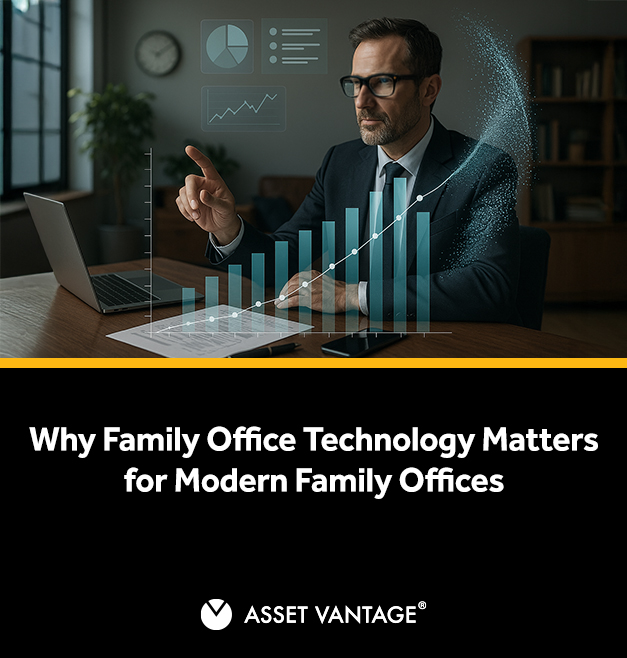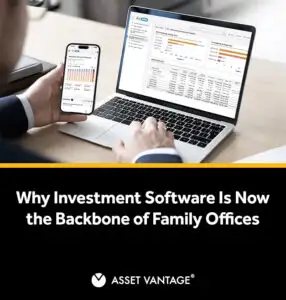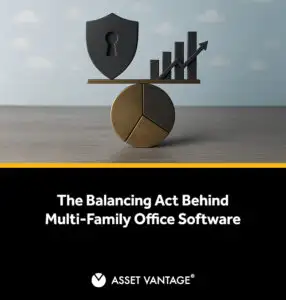Read Time14 Mins
- Why Family Office Technology Matters for Modern Family Offices
- Core Technology Needs Across Single and Multi-Family Offices
- Common Challenges Across Family Offices
- Technology in Investment Management and Private Assets
- Operational Efficiency and Cost Control
- Strategic Decision-Making Enabled by Technology
- Continuity, Succession, and Governance Enforcement
- Business Managers and Advisors: How They Use Technology
- The Future of Family Office Technology
- From Pain Points to Practical Solutions: A Family Office Technology Diagnostic
Why Family Office Technology Matters for Modern Family Offices
Modern family offices handle more than investment oversight.
- Operational Efficiency: Reduces reliance on added staff and eliminates errors from reconciliation across accounts and entities.
- Accurate Reporting: Connects wealth data, accounting, and banking systems to produce consolidated, audit-ready reports.
- Informed Investment Decisions: Centralizes investment data aggregation so principals and investment managers can track performance across asset classes, including private equity and alternative investments.
- Risk Management: Real-time dashboards highlight exposures and liquidity positions across multi-asset portfolios.
- Scalability: The best family office software supports both single-family offices and multi-family offices, adapting to complexity without losing control.
Core Technology Needs Across Single and Multi-Family Offices
| Area of Focus | Single-Family Offices | Multi-Family Offices |
|---|---|---|
| Governance | Bespoke systems aligned to one family’s values and governance rules. | Standardised frameworks that can adapt to multiple client governance models. |
| Data Integration | Consolidation of personal assets, family business holdings, and trusts into one system. | Aggregation across families, entities, and investment companies is often cross-border. |
| Investment Tracking | Direct positions in private equity, real estate, and illiquid assets require tailored tracking. | Broader coverage for alternative investments and pooled portfolios across clients. |
| Reporting | Customised reporting for family members and decision makers, usually private and internal. | Scalable reporting platforms that deliver consolidated reports for multiple families. |
| Confidentiality & Control | Emphasis on private data security and internal-only access. | Strong permissions to separate families’ data while allowing efficiency at scale. |
| Cost & Operations | Higher per-family cost to maintain bespoke systems. | Focus on software solutions and managed services for cost efficiency across clients. |
Unique Challenges of Single-Family Offices
- Codify governance policies and approvals within the system.
- Support investment committee processes with structured workflows.
- Embed reporting protocols that give family members clarity without over-reliance on manual data handling.
- Consolidate family business holdings, personal assets, and trusts in one reporting platform.
- Automate investment data aggregation across custodians, banks, and alternative assets.
- Use family office accounting software that reconciles ledgers with cash, tax, and investment flows.
- Track commitments, valuations, and waterfalls for private equity holdings.
- Capture performance reporting for illiquid assets and alternative investments.
- Provide customised reporting for family office professionals managing private markets.
Because systems serve only one family, privacy and security are paramount. Bespoke solutions often fall short because they are expensive to maintain and hard to integrate.
Unique Challenges of Multi-Family Offices
Multi-family offices operate on a larger scale, serving multiple clients with diverse structures, priorities, and portfolios. Unlike single-family offices, they need technology that supports efficiency, consistency, and secure data sharing while maintaining the integrity of each client’s reporting. Modern platforms must strike a balance between the complexity of diverse holdings and the need for streamlined family office management.
- Generate consolidated reports across clients, entities, and asset classes with consistent definitions.
- Produce customised reporting for families with varied governance frameworks.
- Provide scalable reporting platforms that can handle inputs from banks, custodians, and investment companies.
- Aggregate investment data across jurisdictions, currencies, and tax regimes.
- Automate reconciliations to reduce manual errors in cross-border transactions.
- Ensure compliance with local and international reporting requirements.
- Use standardised workflows to reduce operational overhead.
- Apply software solutions that scale across families while allowing tailored outputs.
- Leverage managed services to supplement teams where needed and reduce the cost of ownership.
- Track commitments and valuations for private equity and alternative investments.
- Monitor multi-asset portfolios for liquidity, exposure, and risk management.
- Provide tools for asset managers and advisors to analyse performance and generate actionable insights.
Common Challenges Across Family Offices
Entity and Ownership Management
- Consolidate trusts, SPVs, and partnerships into a single system of record.
- Automate reconciliation of cross-border holdings and multi-jurisdiction entities.
- Link ownership data to portfolio data, ensuring investment oversight is directly tied to the structure.
Cash and Liquidity Visibility
- Forecast liquidity needs to avoid surprises during capital calls or distributions.
- Provide business managers and financial advisors with dashboards that distinguish free vs restricted cash.
- Use real-time feeds and automated data capture to update balances across accounts.
Private Markets Tracking
- Track private equity holdings, venture capital commitments, and other private investments in one reporting platform.
- Capture waterfalls, distributions, and valuations consistently across asset classes.
- Provide consolidated reports that align with other investment portfolios for true comparability.
Tax, Audit, and Compliance Automation
- Automate capture of backdated transactions, FX, and multi-currency flows.
- Embed controls that produce accurate reporting and reduce audit adjustments.
- Integrate with tax output tools for compliance across multiple jurisdictions.
Reconciliation Across Accounts, Entities, and Ledgers
- Sync accounting, banking, and investment data aggregation into a single ledger.
- Ensure numbers in the general ledger always match external bank and investment statements.
- Apply managed services where needed to streamline data feeds and support internal teams.
Technology in Investment Management and Private Assets
Portfolio Management and Asset Allocation Tools
- Combine liquid and illiquid assets into one investment portfolio analysis framework.
- Support both tactical rebalancing and long-term asset allocation.
- Provide dashboards that benchmark investment performance against global indices.
- Deliver relevant data to principals and investment managers for faster, better calls.
Private Equity Technology for Family Offices
- Track commitments, valuations, and capital calls for both funds and co-investments.
- Capture waterfalls, fees, and distributions transparently.
- Provide reports that satisfy both families and outside private equity firms or auditors.
- Integrate with broader reporting platforms to keep data consistent across investment firms.
Families avoid blind spots when private equity sits within the same system as other asset classes.
Alternative Investments and Private Assets
- Track private assets alongside traditional holdings in one reporting platform.
- Monitor private investments, including venture, real estate, and illiquid opportunities.
- Generate consolidated reports that reflect total exposure across multi-asset portfolios.
- Provide scenario analysis to help decision-makers understand risk-return profiles.
Performance Reporting and Scenario Planning
- Produce reports that show investment performance across liquid and illiquid holdings.
- Enable “what-if” models for asset allocation and cash deployment.
- Link reporting to risk management frameworks that identify concentration or exposure limits.
- Support informed investment decisions by tying analytics back to family governance.
Operational Efficiency and Cost Control
Family offices cannot scale by adding more staff alone. Manual reconciliations drain resources, increase errors, and raise operational risk. The right technology brings efficiency by automating repetitive work, consolidating data, and delivering insights that reduce cost while improving control.
Automating Manual Data Handling
- Eliminate manual data handling by capturing transactions through automated data feeds.
- Provide seamless access to reconciled balances and reports.
- Reduce the burden on internal teams by relying on specialised service providers for integrations.
- Free up staff to focus on analysis and governance instead of administration.
Advanced Reporting Platforms
- Deliver customised reporting packs aligned to governance needs.
- Generate consolidated reports that integrate portfolio data from multiple custodians and entities.
- Provide dashboards that highlight relevant data for principals and advisors.
- Ensure accurate reporting that supports governance, tax, and compliance reviews.
Strategic Decision-Making Enabled by Technology
Investment Data Aggregation for Informed Decisions
- Eliminate silos by pulling portfolio data from custodians, banks, and partnerships into one platform.
- Produce dashboards that highlight investment performance across both liquid and illiquid holdings.
- Support advisors, wealth managers, and asset managers with the same reconciled data.
- Provide relevant data so decisions are based on facts, not assumptions.
Optimizing Cash Deployment and Asset Allocation
- Forecast liquidity to ensure cash is deployed where it delivers impact.
- Balance asset allocation across equities, fixed income, and alternatives.
- Embed risk management checks that flag concentration or exposure issues.
- Provide visibility so principals and investment firms can act quickly.
Benchmarking and Market Insights
- Compare investment portfolios against indices and peer groups.
- Use portfolio analysis tools to test rebalancing and diversification strategies.
- Provide investment managers and advisors with data-driven insights for informed future positioning.
- Align strategies with both the market environment and the family’s long-term vision.
Continuity, Succession, and Governance Enforcement
Preserving Institutional Memory
- Store ownership structures, trusts, and beneficiary records in one secure platform.
- Link records to governance structures and policies for accountability.
- Provide accurate reporting that captures both financial flows and governance actions.
- Ensure access for designated family members while protecting confidentiality.
Preparing the Next Generation
- Use scenario planning to show the impact of investment decisions.
- Provide transparent reports that explain allocations and exposures.
- Create role-based dashboards to involve younger family members in governance from an early stage.
- Align succession planning with the family’s values and long-term success goals.
Governance Enforcement Through Technology
- Set exposure limits and risk thresholds tied to policy.
- Trigger alerts when breaches occur across portfolios or entities.
- Automate checks for compliance with internal and external reporting requirements.
- Embed controls so decisions align with the family’s strategic vision.
Business Managers and Advisors: How They Use Technology
Wealth Management and Advisory Services
- Provide secure access to wealth data across entities and asset classes.
- Enable portfolio analysis tools that highlight allocation, risk, and performance.
- Deliver reporting packs that improve transparency and client service.
- Support advisors in building strategies that align with family governance and long-term goals.
Service Providers and Managed Services
- Service providers deliver managed services that reduce the load on internal teams.
- Software solutions ensure reconciliations, reporting, and compliance remain accurate.
- Integrated reporting platforms provide providers with the same data that families and advisors see.
- Outsourcing routine work lets families focus on governance and strategy.
The Future of Family Office Technology
AI in Investment Data Aggregation and Analytics
- Automate data capture from banks, custodians, and investment platforms.
- Apply investment analytics that highlight patterns, risks, and opportunities.
- Use AI-driven tools to measure investment performance across liquid and illiquid assets.
- Deliver insights that help families benchmark portfolios and act faster.
AI ensures families spend less time gathering numbers and more time interpreting what they mean. In practice, AI already reduces operator burden. It flags outlier transactions before audits, predicts liquidity needs by learning from past capital calls, and reconciles mismatched entries in minutes. These are not abstract promises but immediate applications that lower operational risk.
Automating Complex Structures and Multi-Asset Portfolios
- Manage complex partnership structures without relying on spreadsheets.
- Consolidate data across multi-asset portfolios, including private equity, real estate, and alternatives.
- Improve accuracy with built-in compliance checks and scenario modelling.
- Support accurate reporting across entities, asset classes, and jurisdictions.
The Evolution of Family Office Operations
- Replace fragmented systems with integrated platforms that scale with the family.
- Standardise processes so that a large number of family offices can adopt best practices.
- Ensure long-term resilience by embedding governance, risk, and compliance into workflows.
- Use technology solutions that support not just reporting but strategic decision-making.
From Pain Points to Practical Solutions: A Family Office Technology Diagnostic
| Function | Need | Pain Point (What Goes Wrong) | Feature / Capability | Solution (What Works in Practice) |
|---|---|---|---|---|
| Entity & Ownership Management | Maintain clear, centralized entity and ownership records | Manual spreadsheets create errors in trust structures, SPVs, and cross-border holdings; institutional memory is lost when staff leave | Automated entity registers, consolidated ownership dashboards, and audit-ready logs | Integrated platforms that simplify complex partnership structures and preserve continuity across generations, reducing legal and governance risk |
| Cash & Liquidity Visibility | Real-time view of true liquidity | Cash reports overstate availability by mixing earmarked and free balances; capital calls surprise the office; forecasts are unreliable | Liquidity dashboards, automated bank feeds, scenario modelling | Tools that forecast liquidity accurately, highlight restrictions, and give business managers and principals clarity to deploy cash strategically |
| Investment Oversight | Unified picture of all holdings | Private investments, illiquid assets, and alternative investments sit in disconnected files; no view of risk-return across the whole portfolio | Portfolio management, asset allocation tools, consolidated dashboards | An intelligent family office suite that integrates liquid and private markets, delivering relevant data for better allocation and informed investment decisions |
| Performance Reporting | Transparent reporting and benchmarking | Families rely on PDFs and lagging data; inconsistent benchmarks hide weak spots in investment performance | Customised reporting, real-time performance dashboards, benchmarking tools | Reporting platforms that provide accurate reporting, scenario planning, and drill-through to transactions for full accountability |
| Tax, Audit, Compliance | Lower risk and audit cost | Manual reconciliations in FX, multi-currency, and backdated transactions create errors and audit penalties | Automated data capture, compliance checks, and integrated tax outputs | Family office accounting software that embeds tax and audit workflows, ensuring long-term success with fewer surprises |
| Document Management | Secure and streamlined records | Paper files and siloed systems expose private data and slow down compliance. | Digital document vaults, encryption, and audit logs | Modern document platforms that protect family office operations, align with regulators, and deliver governance-ready transparency |
| Operational Efficiency | Do more with lean teams | Staffing costs rise because reconciliations and reporting are handled manually; duplication is common | Managed services, API connectors, automated reconciliations | Software solutions combined with trusted service providers that bring scale, efficiency, and resilience without additional headcount |
| Succession & Governance | Engage next generation, enforce governance | Heirs lack visibility into decisions; policies exist but are ignored; governance weakens over time | Scenario planning tools, policy alert engines, and role-based dashboards | Technology that helps multigenerational families prepare the next generation, enforce governance rules, and align decisions with family values |
| Advisor Collaboration | Give advisors access to consistent data | Financial advisors, wealth managers, and auditors work off different reports; response times are slow | Advisor dashboards, role-based permissions, consolidated reporting packs | Platforms that ensure financial advisors, investment managers, and asset managers see the same data as families, improving client service and outcomes |







